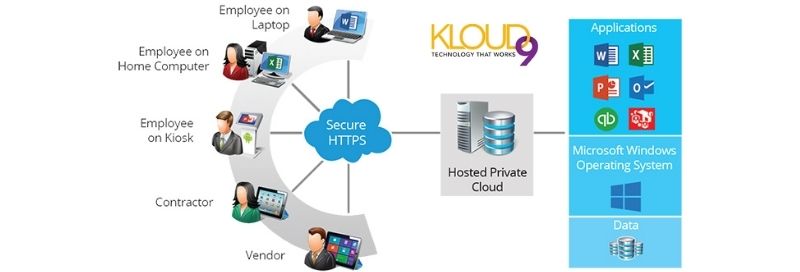Hosted Virtual Desktop or HVD is a cloud-hosted desktop environment that runs as a virtual machine. It is a desktop solution that leverages virtual software. The virtual software is from a service provider like Amazon, VMware, and Microsoft. The device that gets this virtual software must be internet-enabled.
Rather than keeping data and business applications on local computers, HVD stores them in the IT facilities of the vendors. Just like physical computers, users will be able to access the data and applications stored on the IT infrastructure from their office. Security is also ensured after logging in to an HVD because its data and application are separated from the personal data of the user.
Just like traditional desktop computers, an HVD creates a desktop environment for the user. However, HVD offers more flexibility and freedom such that you can work from anywhere. This is made possible because the data on HVD can be accessed on a central server provided by a service provider.
The HVD service providers also provide services and management consoles. They have the responsibility of storage, security, updates, and backup of data and applications. This provision can enable users and customers to focus on other tasks that are important for their business.
Differences Between Hosted Virtual Desktop (HVD) and Virtual Desktop Infrastructure (VDI)
Often misunderstood by many people, both HVD and VDI are two desktop solutions that are completely different. Although they are both types of desktop virtualization techniques, the difference is the location and control of the IT infrastructure.
HVD is seen by the user as an interface connecting and storing data on the infrastructure of the service provider. Provided the local machine runs on the internal network of an organization, an employee will be able to access all data and applications. The IT infrastructure of the service providers is not procured, secured, and managed on the organization’s premises. The service provider has the responsibility of maintaining its infrastructure.
Unlike the implementation of an HVD, the VDI allows for a central server to host the desktop operating systems in the premises of the company. To implement VDI, the IT infrastructure must be owned by the organization. This provides better visibility and control. However, the security, maintenance, and management of the data center are the responsibility of the organization.
How HVD Works
HVD is a service that is provided by a third party. For every user using their cloud desktop service, the service provider gives them unique login credentials. It is these credentials that will be used when accessing the virtual desktop. Data and applications on the virtual desktop can be accessed from any location and device.
For instance, an employee that needs to work on a task after office hours can still get the job done. If the employer is at home or anywhere else, all that’s needed to access work data and application is the log-in credential provided by the service provider. By making use of these credentials, an employee can continue work from where he stopped.
Generally, it is convenient for an employee to use a cloud-hosted desktop environment that runs as a virtual machine. This service makes business flexible and agile. These qualities enhance the efficiency and productivity of the organization.
Benefits of HVD
The explosive growth of mobile devices has made the use of traditional desktops rare in recent times. Together with the advent of mobile devices, the bring-your-own-device (BYOD) industry has made the work environment more flexible.
One of the requirements of the modern workplace is that organizations can manage multiple devices for each user. Also, users must be able to access data and applications from anywhere and at any time. All these challenges are what HVD looks to overcome in the workplace. HVD makes work more mobile and flexible while optimizing cost and employee productivity.
Some of the benefits that using HVDs brings include enhanced flexibility, better reliability and security, smoother user experience, easier maintenance, and lower costs. Below are the benefits in details:
Easy upgrades and maintenance
When the virtual desktop is hosted offsite, an organization’s upgrade and maintenance become considerably less. The responsibility of maintaining all infrastructures falls on the HVD service provider.
Rather than performing patches and security upgrades on multiple devices, it only needs to be installed one time on the central server. Using HVD will limit the workforce needed for the upkeep of the hardware.
Enhanced security and reliability
Wherever HVD is deployed, the service provider is responsible for data storage and backup. This is a feature that is critical in the event of hardware failure. Another responsibility of the service provider is delivering all data and applications on the virtual desktop to the user securely. When a centralized location is used for data storage, it becomes convenient to install authorization and authentication, as well as access control policies implementation.
By separating business and personal environments, HVD gives maximum data security.
Great user experience
The desktop experience from using HVD is more convenient at multiple endpoints. An individual user can customize the application and theme on their virtual desktop just as in a traditional desktop. All settings and preferences of the user are also stored so he or she can continue from where he stopped.
More flexibility
Most cloud services enable a more flexible and remote-friendly work environment. The use of HVD ensures that work is no longer confined to the office alone. Through the internet connection of HVD, work desktops can be securely accessed from anywhere and at any time. Using HVD eliminates the need for VPNs.
Low operational cost
The low operational cost is the main benefit that HVD has over traditional PCs. Having the capability of accessing data and applications stored on cloud services can save organizations money for procuring and upgrading hardware. With HVD, the virtual desktop is easily accessible to the employees through personal portable devices.
Conclusion
HVD is a virtual desktop solution for many organizations. It offers a sophisticated and modern solution for a remote work environment. Data and applications stored on any of the cloud services are secure. Using HVD will be of great benefit to any organization.





You must be logged in to post a comment.